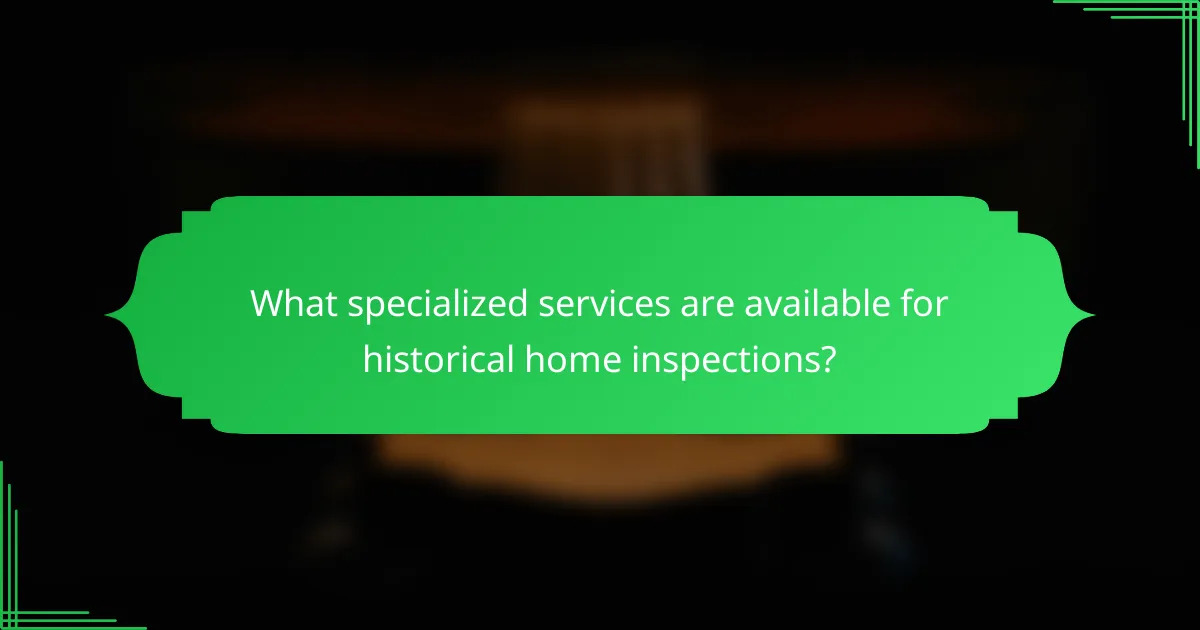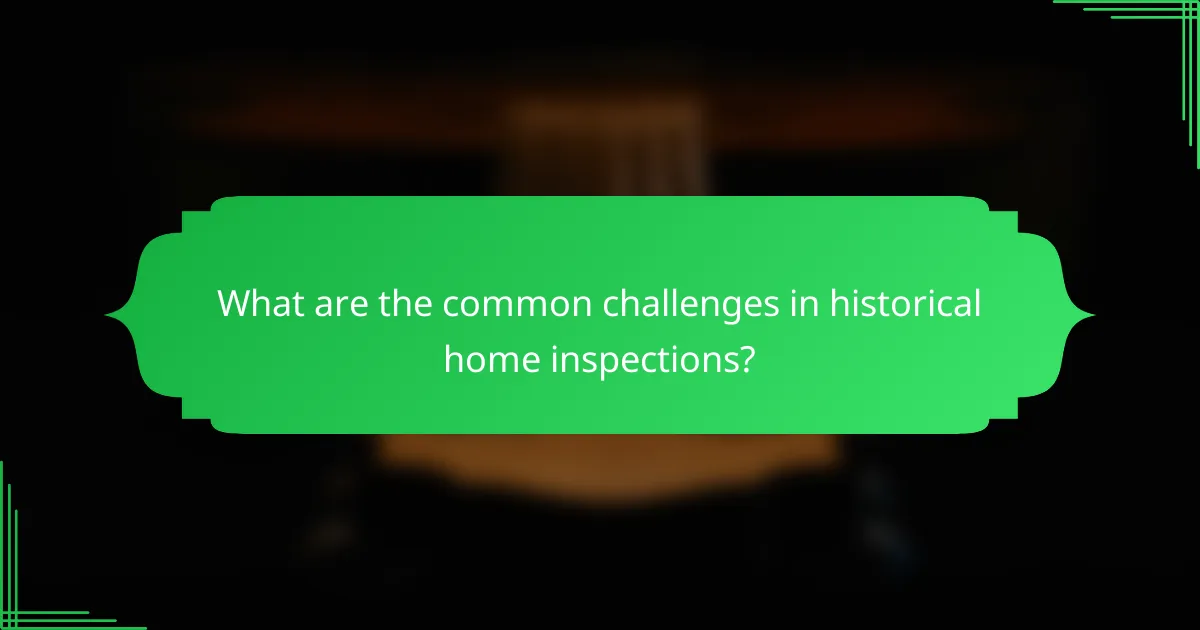When considering a historical home inspection, it’s essential to understand the various pricing factors that influence the overall cost, such as the property’s age, location, and the complexity of the inspection. Specialized services tailored to older homes ensure that their unique characteristics are preserved while addressing necessary repairs. By evaluating the inspection findings, homeowners can effectively budget for repairs and create a realistic financial plan for maintaining their historic property.

What are the pricing factors for historical home inspections in the US?
The pricing for historical home inspections in the US varies based on several key factors, including the property’s age, location, inspection complexity, inspector qualifications, and any additional services required. Understanding these elements can help homeowners budget effectively for inspections and potential repairs.
Property age and condition
The age and condition of a historical home significantly influence inspection costs. Older homes may require more thorough inspections due to outdated systems, structural concerns, or historical preservation requirements. Inspectors often charge higher fees for properties that present unique challenges or require specialized knowledge.
For instance, a home built in the early 1900s may have hidden issues like lead paint or outdated electrical systems, necessitating a more detailed examination. Homeowners should expect to pay more for inspections on properties that are not only older but also in poor condition.
Location and market demand
Location plays a crucial role in determining inspection pricing. Homes in urban areas or regions with high demand for historical properties often incur higher inspection fees due to increased competition and cost of living. For example, inspections in cities like San Francisco or New York may be more expensive than in rural areas.
Additionally, local regulations and the availability of qualified inspectors can affect pricing. In markets where historical homes are prevalent, inspectors may charge a premium for their specialized services.
Inspection scope and complexity
The scope and complexity of the inspection directly impact the overall cost. A standard inspection may cover basic structural and mechanical systems, while a comprehensive inspection might include assessments of historical features, compliance with preservation guidelines, and environmental hazards.
Homeowners should clarify what is included in the inspection to avoid unexpected costs. For example, a detailed inspection that includes a roof assessment, foundation evaluation, and analysis of historical materials will likely cost more than a basic visual inspection.
Inspector qualifications and experience
The qualifications and experience of the inspector can significantly affect pricing. Inspectors with specialized training in historical homes or certifications in preservation techniques may charge higher fees due to their expertise. It’s essential to consider the inspector’s background when budgeting for an inspection.
Homeowners should seek inspectors who are familiar with local historical regulations and have a proven track record in assessing similar properties. Investing in a qualified inspector can save money in the long run by identifying potential issues early.
Additional services required
Many historical home inspections may require additional services, such as pest inspections, radon testing, or specialized assessments for lead or asbestos. These services can add to the overall cost of the inspection.
Homeowners should anticipate these potential extra costs and consider bundling services with the same inspector when possible. This approach can often lead to discounts and a more comprehensive understanding of the property’s condition.

What specialized services are available for historical home inspections?
Specialized services for historical home inspections focus on assessing the unique needs and challenges of older properties. These services ensure that the integrity and historical value of the home are preserved while addressing any necessary repairs or renovations.
Structural assessments
Structural assessments evaluate the stability and integrity of a historical home’s framework, including foundations, walls, and roofs. Inspectors look for signs of deterioration, such as cracks, sagging, or water damage, which are common in older buildings.
Homeowners should expect to pay between a few hundred to over a thousand dollars for a thorough structural assessment, depending on the home’s size and complexity. Engaging a specialist familiar with historical architecture can provide insights into specific issues that may not be apparent in standard inspections.
Preservation consulting
Preservation consulting involves expert advice on maintaining and restoring historical features while adhering to preservation standards. Consultants guide homeowners on appropriate materials, techniques, and practices that align with historical preservation guidelines.
Costs for preservation consulting can vary widely, typically ranging from $100 to $250 per hour. Homeowners should consider this investment to ensure that renovations enhance rather than detract from the home’s historical character.
Environmental hazard evaluations
Environmental hazard evaluations assess potential risks such as lead paint, asbestos, and mold, which are often found in older homes. These evaluations are crucial for ensuring the safety of occupants and compliance with health regulations.
Depending on the extent of testing required, costs can range from a few hundred to several thousand dollars. Homeowners should prioritize these evaluations, especially if planning extensive renovations that may disturb hazardous materials.
Restoration project management
Restoration project management oversees the entire process of restoring a historical home, coordinating between contractors, suppliers, and preservationists. Effective management ensures that the project stays on schedule and within budget while meeting preservation standards.
Project management fees can vary, typically ranging from 10% to 20% of the total project cost. Homeowners should seek professionals with experience in historical restorations to navigate the complexities of such projects successfully.

How can homeowners budget for repairs after a historical home inspection?
Homeowners can budget for repairs after a historical home inspection by assessing the findings and estimating potential costs. Understanding the scope of necessary repairs and prioritizing them will help create a realistic financial plan.
Estimating repair costs
Estimating repair costs involves reviewing the inspection report and identifying specific issues that need attention. Common repairs for historical homes may include roof replacements, foundation work, or plumbing updates, which can range from a few hundred to several thousand dollars depending on severity and materials.
To get accurate estimates, consider obtaining quotes from multiple contractors who specialize in historical renovations. This will provide a clearer picture of the financial commitment required and help identify any unexpected expenses.
Prioritizing essential repairs
Prioritizing essential repairs is crucial for effective budgeting. Focus first on repairs that affect safety and structural integrity, such as electrical systems or roof leaks. These repairs should take precedence over cosmetic updates, which can be addressed later.
Creating a list of repairs ranked by urgency can help streamline the budgeting process. For example, if a roof leak is detected, it should be fixed before addressing paint or flooring issues.
Finding financial assistance options
Homeowners can explore various financial assistance options to help cover repair costs. Local and federal programs may offer grants or low-interest loans specifically for historical home renovations. Researching these options can provide significant savings.
Additionally, some nonprofit organizations focus on preserving historical properties and may offer funding or resources. Engaging with local preservation societies can also yield valuable information on available financial support tailored to historical homes.

What are the common challenges in historical home inspections?
Historical home inspections often face unique challenges due to the age and condition of the property. Inspectors must navigate hidden issues, comply with local regulations, and access hard-to-reach areas, all of which can complicate the inspection process.
Identifying hidden issues
Hidden issues in historical homes can include outdated electrical systems, plumbing problems, and structural weaknesses. Inspectors need to be vigilant and knowledgeable about common problems associated with older homes, such as lead paint or asbestos, which may require specialized testing.
To identify these hidden issues, inspectors often use advanced tools like thermal imaging cameras and moisture meters. Homebuyers should be prepared for potential additional costs if significant problems are discovered during the inspection.
Compliance with local regulations
Historical homes are often subject to specific local regulations and preservation guidelines. Inspectors must be familiar with these rules to ensure that any renovations or repairs comply with local standards, which can vary significantly by location.
For instance, in some areas, modifications to the exterior must maintain the original architectural style. Homebuyers should consult local historical societies or preservation boards to understand the regulations that may affect their property.
Accessing hard-to-reach areas
Accessing hard-to-reach areas in historical homes, such as attics, crawl spaces, and behind walls, can be particularly challenging. These spaces often contain critical components like insulation, wiring, and plumbing that need thorough inspection.
Inspectors may need to use ladders or specialized equipment to safely access these areas. Homebuyers should consider requesting a more detailed inspection if certain areas are difficult to access, as this could reveal hidden problems that could lead to costly repairs later on.
